© 2013 PineTree Multimedia Productions.
All Rights Reserved for original written material.

From The Center for American Music Preservation (CAMP)
A Centennial Tribute
to Jerome Moross


An Essential Film Music Guide
.jpg)
Get Your Copy of this valuable book by respected film music historian and critic,
Roger L. Hall. Included in the book are discussions of representative film songs and scores, interviews with several composers,
and
comments by film composers, plus a list of
100 Essential Film Scores of the 20th Century.
Read more about this book by clicking this link --
A GUIDE TO FILM MUSIC: SONGS AND SCORES

Biography and Classical works
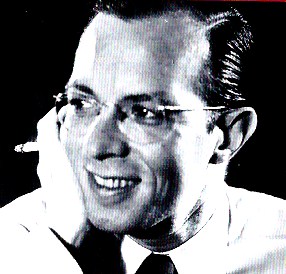
born: New York, New York, 1 August 1913
died: Miami, Florida, 25 July 1983
Jerome Moross was never really comfortable with the glitzy world of Hollywood, preferring a more cultural and artistically fulfilling existence in New York. He never actually settled in California but commuted: "I only went to Los Angeles when I had a film to do or when I needed the money." Then he would return to New York to continue with his concert and theatrical works. probably because of this dual career Moross was never quite in vogue. -- James Fitzpatrick
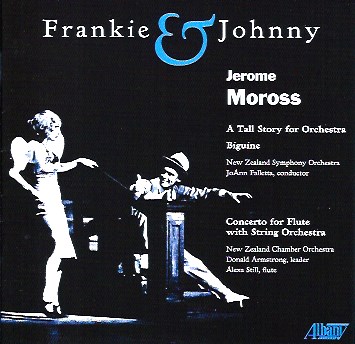
Frankie & Johnny and other works
.jpg)
Symphony No. 1 and other works
Like his friends, Aaron Copland and Bernard Herrmann, Jerome Moross did not spend all his time writing film scores. He also produced theatrical works such as the revue, PARADE, in 1935, and the ballet score for THE NOTORIOUS LIFE OF FRANKIE AND JOHNNY in 1938. He also composed several outstanding classical works, such as his Symphony No. 1, premiered by the Seattle Symphony and conducted by Sir Thomas Beecham on 18 October 1943.
He also composed some fine songs which are available on this recommended CD:
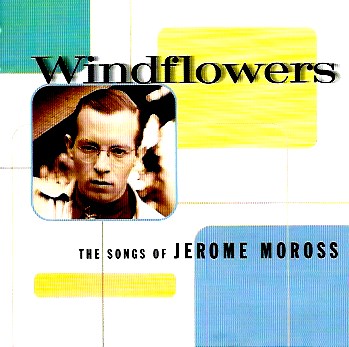
Windflowers - The Songs of Jerome Moross
One of his last chamber works is a marvelous twenty minute work titled, Sonata for Piano Duet and String Quartet in G Major, completed in 1975 and available on this highly recommended CD:
Chamber Music of Bernard Herrmann and Jerome Moross

Film music
His first score was for the film, CLOSE-UP, in 1948. Most of his film scores were composed in the 1950s and include these titles: WHEN I GROW UP (1951), SEVEN WONDERS OF THE WORLD (a few memorable cues for this epic 1956 Cinerama film), THE SHARKFIGHTERS (1956), THE PROUD REBEL (1958), THE JAYHAWKERS (1959).
But the film score he will be best known for was THE BIG COUNTRY (1958), for which he was nominated for an Oscar for Best Original Film Score. It opens with a sprawling main theme which is a classic piece of the American West. This is one of the great western film scores along with HIGH NOON, THE SEARCHERS and THE MAGNIFICENT SEVEN. It is included on the list of 100 Essential Film Scores of the 20th Century.
CD: THE BIG COUNTRY (1958)
In her CD notes to THE VALLEY OF GWANGI, a collection of eight film score suites and themes by Jerome Moross, the following summary of his career was written by his daughter, Susanna Moross Tarjan:
He achieved great theatrical success in the immediate post-war years and devoted the last years of his life to chamber music. However, it will be for his film music that he will be best remembered: music which has both an instant popular appeal and an underlying strength of musical purpose: "I do feel that a composer should be able to write down on paper not only what he feels, but to do it in such a way that his audience experiences his emotions anew."
See this highly recommended book,
Lifetime Achievement Award
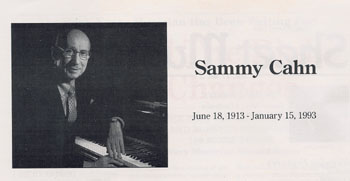
Since 1988, there have been annual film music awards, named by film music critic, Roger Hall, in honor of lyricist Sammy Cahn, who received 4 Oscars and was nominated more times than any other songwriter -- 26 times in all.
These awards are known as the Sammy Film Music Awards (or Sammys) and have been presented for current and past soundtracks. They are the longest-running awards exclusively for film music recordings.
These are past composers and arrangers chosen for the Lifetime Achievement Award (in the order of their listing):
Bernard Herrmann, Henry Mancini, Alfred Newman, Max Steiner, Miklos Rozsa, Erich Wolfgang Korngold, Dimitri Tiomkin, Franz Waxman, Victor Young, Hugo Friedhofer, Johnny Green, Bronislau Kaper, Alex North, Elmer Bernstein, Jerry Goldsmith, Ken Darby, Aaron Copland, John Barry, and David Raksin.
The songwriters and lyricists who have been chosen are:
Sammy Cahn, Johnny Mercer, James Van Heusen, Harry Warren,
Jay Livingston and Ray Evans.
For 2013, the 25th Annual Sammy Lifetime Achievement Award for a past film composer was presented to Susanna Moross Tarjan in memory of her father,
Jerome Moross (1913-1983).

Sammy Film Music Awards 2013

CD Review No. 1:
THE BIG COUNTRY (1958)
Music composed and conducted by Jerome Moross
42 Tracks (Playing Time = 74:00)
Executive Album Producers: MV Gerhard and Matt Verboys. Produced for La-La Land Records by Ford A. Thaxton. Digitally Mixed and Mastered by James Nelson. CD booklet notes by Randall D. Larson. CD Art Direction: Mark Banning.
La-La Land Records LLLCD 1055
Limited Edition - 3000 Units
Rating: ****
Track Titles
1. Main Title (3:21)
2. Julie's House (2:10)
3. The Wedding (3:09)
4. The Hazing (1:49)
5. Courtin' Time (1:21)
6. The Terrill Ranch (1:35)
7. Old Thunder (1:40)
8. The Raid, Parts 1 & 2 (3:39)
9. McKay's Decision (1:03)
10. The Capture (1:28)
11. McKay's Triumph (0:35)
12. Major Terrill's Party (1:30)
13. Major Terrill's Party, Part 2 (1:09)
14. Waltz (2:16)
15. Polka (0:54)
16. Night in Blanco Canyon (0:52)
17. McKay's Ride (1:20)
18. McKay is Missing (2:02)
19. The Old House (2:18)
20. Waiting (0:30)
21. Horror Stories (1:04)
22. Big Muddy (2:33)
23. Still Waiting (1:37)
24. McKay Alone (1:20)
25. Night at Ladder Ranch (1:09)
26. The Fight (2:54)
27. Cattle at the River (2:21)
28. Pat's Mistake (1:20)
29. Buck Comes for Julie (1:12)
30. The Abduction (1:10)
31. The Captive (1:34)
32. The Attempted Rape (2:10)
33. The War Party Gathers (2:39)
34. McKay in Blanco Canyon (2:27)
35. Jim and Julie (0:35)
36. The Major Alone (1:51)
37. The Duel (0:51)
38. The Death of Buck Hannassey (2:44)
39. Ambush in Blanco Canyon - Part 1 (1:16)
40. Ambush in Blanco Canyon - Part 2 (1:47)
41. The Stalking (1:21)
42. End Title (1:59)
For those who have seen and enjoyed THE BIG COUNTRY this CD release will come as a special pleasure, especially after waiting for nearly 50 years for a complete version.
To list the many fine actors in this popular western, they are:
Gregory Peck (Jim McKay), Carroll Baker (Patricia Terrill),
Jean Simmons (Julie Maragon), Charles Bickford (Major Henry Terrill), Charlton Heston (Stev Leech), Chuck Connors (Buck Hannassey) and Burl Ives in an Oscar-winning performance as Rufus Hannassey.
The new CD is more satisfying and has more music than the re-recording released by Silva in 1988.
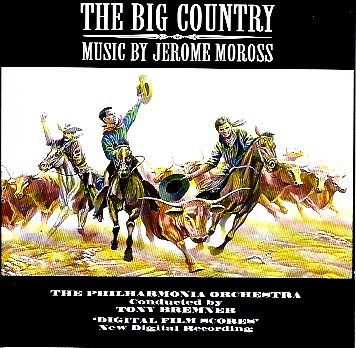
This CD with The Philharmonia Orchestra, conducted by Tony Bremner and Produced by Christopher Palmer has a playing time of 55:15. The new La-La Land CD adds almost 20 minutes to the playing time and is the original soundtrack conducted by Jerome Moross.
In 1997, I ran a web poll of favorite film scores, and THE BIG COUNTRY came in at No. 6 (in a tie with Elmer Bernstein's TO KILL A MOCKINGBIRD). That just demonstrates the popularity of this sprawling western epic.
THE BIG COUNTRY is also on my list of 100 Essential Film Scores.
There is no need to write a long review here since this score by Jerome Moross is one of the great western film scores.
The opening Main Title is famous for its swirling violin argeggios and prominent use of horns and timpani. It set the stage for another memorable western Main Title two years later -- Elmer Bernstein's THE MAGNIFICENT SEVEN. Unlike many of the western scores from that era, like HIGH NOON, neither of these westerns have a title song. They don't need them.
Many of the more than 40 cues on THE BIG COUNTRY CD are rather short but the rhythmic flow of the music is continuous and provides plenty of excitementt, including a bunch of delightful dance cues, such as tracks 14 and 15.
One of the most thrilling cues is "The Welcoming" (track3), and as Randall Larson writes : "the music's rhythm along with the braying urgency of the horns, which here and elsewhere thoughout the score will signify the belittling bravado o fthe cowboys, drives the sequence fastly onward."
Randall Larson's excellent booklet notes are titled, "Big Music for The Big Country." His coverage is extensive with subject headings covering "The Movie"; "The Composer"; "The Score"; and "Track-by-Track" descriptions. There should be more CD notes that are this comprehensive.
The CD booklet is beautifully designed by Mark Banning, with many film photos and a complete list of the Orchestra Personnel. This list is of special interest because it includes a few future well known composers: Dominic Frontiere on Accordion, and John T. Williams as one of three pianists used for the soundtrack recording. Also featured is the popular Larindo Almeida on Guitar.
This is a first class CD production and all who were involved deserve high praise for their efforts.
One of the best releases of a vintage soundtrack this year.
--Roger Hall, June 2007
Updated news:
Unfortunately, this excellent CD is no longer available.

CD Review No. 2
THE CARDINAL - The Classic Film Music of Jerome Moross
The City of Prague Philharmonic, conducted by Paul Bateman and Nic Raine. Executive Producers: Susanna Moross Tarjan and Reynold da Silva. Produced by James Fitzpatrick. Associate Producers: Rickie Clark and Nic Raine. Chief Recording Engineer: John Luard Timperley. Assistant Engineer: Jan Holzner. Recorded at Smecky Studios, Prague, June 2000.
Silva Screen SILKD 6030 (2 CDs).
Rating: ****
Disc One (7 Tracks = 42:30)
Disc Two (10 Tracks = 42:11)
If you're one of the many who thinks that THE BIG COUNTRY is one of the best western film scores of the 20th century, then you should be thrilled with this new two disc compilation of the music of Jerome Moross.
This is a generous sampling from seven of his scores composed between 1948 and 1963. Five of his scores have world premiere recordings on this compilation. Much of the music is not available anywhere else so the value of this collection is extraordinary.
Disc one begins with three tracks totaling over sixteen minutes from THE JAYHAWKERS (1959). Like THE BIG COUNTRY from the previous year, THE JAYHAWKERS has a broad wide open spaces sweep to it. The opening Main Titles music is similar to TBC and is every bit as memorable. This is followed by a quieter cue for Cam Bleeker, a Mexican war hero. Track 2 is divided into three cues: "The Lynching"/ "The Two Brothers"/ "The Jayhawkers." If you listen carefully at about 4 minutes into this track, you'll hear the theme that later became the theme for the popular TV western series,WAGON TRAIN. The third track has three more cues: "Attack on Abilene"/ "Death of Darcy"/ "Finale." The first cue opens very softly then explodes with an orchestral outburst highlighted by darker woodwinds and brass. The Finale ends the suite in grand style.
Next up is music from one of the best Cinerama features, SEVEN WONDERS OF THE WORLD (1956). Filmed at various locations around the world and narrated by Lowell Thomas, this is really just a very colorful travelogue - at least that's the way I remember seeing it as a youngster. I was a huge fan of Cinerama and went to see each of them for the music and spectacular sound as well as the thrilling photography. I had no idea that four different composers were used on SWOTW ( Emil Newman, David Raksin, Sol Kaplan and Jerome Moross). Why has it taken so long to make this wonderful music by Moross available? Track 5 has a cue titled, "The Holy Land" (4:04). This is probably the best track on the entire compilation - a beautiful Hebraic theme first played simply by the woodwinds and a few strings. Then there a series of variations on the theme which add more depth to this haunting melody. The other track from SWOTW is "The Mediterranean" (4:52), with a very graceful theme played by solo flute and a few other instruments. Not quite as impressive as "The Holy Land' but still very memorable.
The other two scores featured on the first disc are also quite good. Track 5 has a suite from CLOSE-UP (1948)(9:11) and track 7 has a suite from THE CAPTIVE CITY (1952)(6:55). Both scores were composed for low-budget hard-hitting films. But they don't shrink from making big statements with their main themes, like Miklos Rozsa did with his film noir classics at that same time.
The second disc contains only two scores: THE PROUD REBEL (1958) and THE CARDINAL (1963). The first score is for a Civil War era film starring Alan Ladd and Olivia de Havilland. The five tracks included in the suite are good, but a bit too heavy-handed for my taste. The opening Main Titles music (2:51) begins with a rather ponderous march known as "Rebel Theme" featuring trumpets, woodwinds and percussions. Next comes "The Wagon Ride/ The Dress" (2:25), with a light bouncy theme to accompany the journey. The remaining three tracks are enjoyable but less memorable.
The final suite on the second disc is for THE CARDINAL. This 1963 film starred Tom Tryon, Carol Lynley, John Huston, Burgess Meredith and others. The suite was arranged by Christopher Palmer just before his death in 1995. As James Fitzpatrick writes in his chatty, informative CD notes about the opening Prologue (track 6 - 3:43) - "the suite opens with the ringing of church bells - in this case we have used the actual bell of St. Peter's in Rome...the music swells in chordal progression from beneath the chimes before the advent of the Cardinal's Theme on strings with a suitably religious horn and woodwind baroque accompaniment that still echoes the peal of the bells." That theme is another glorious one by Moross which is heard in other movements of the suite. It was also used for the beautiful song with a memorable recording made by Frank Sinatra (not in the film), with lyrics by Carolyn Leigh.
My favorite track of the suite is "The Cardinal in Vienna" (Waltz)(6:34). This has an almost giddy theme featuring solo violin and orchestra. [Note: That track was not part of the suite arranged by Christopher Palmer.] It's delightful music, somewhat in the manner of Ravel's famous "La Valse." The last track, "The Cardinal's Decision" (track 10 - 5:10), sums up all that has gone before leading up to a wonderful statement of the main theme as Stephen Fermoyle (Tryon) is ordained as Cardinal.
The playing by the City of Prague Philharmonic Orchestra is first class, under the able direction of Paul Bateman. As explained above, the CD booklet notes by James Fitzpatrick are very well written. An added bonus are several vintage pensive photos of Moross himself, courtesy of Susanna Moross Tarjan, who was also executive producer for this CD compilation.
It seems appropriate that two future film composers would attend the same high school. Moross was a classmate of Bernard Herrmann at DeWitt Clinton High School in New York. As a teenager, Moross played in a trio featuring Herrmann on violin and his brother on cello. Both Moross and Herrmann became lifelong friends, even though they went in different directions and Herrmann's film music is far better known. But this fine Moross collection should help to make his film work better known and more respected.
This is a truly outstanding collection and one of the best yet released in the Silva film composers series.
I highly recommend it for any film score library.
Essential listening. A triumph!
--Review by Roger Hall, 14 February 2001
Note:
THE CARDINAL is listed on the 100 Essential Film Scores of the 20th Century.

Other Film Composer Tributes
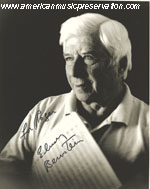
Elmer Bernstein
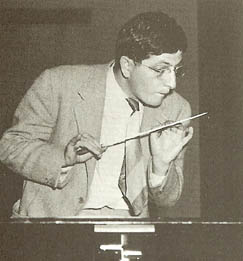
Bernard Herrmann

Henry Mancini
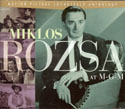
Miklos Rozsa
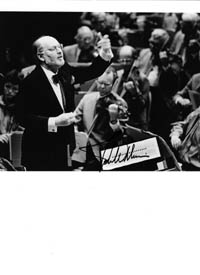
John Williams
